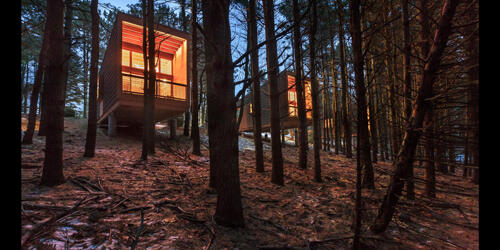 BACK TO HOMEPAGE >
BACK TO HOMEPAGE >

Whitetail Woods Regional Park Camper Cabins | Whitetail Woods Regional Park, Farmington, Minnesota | 2014
Architects: HGA Architects and Engineers
Design Team: Jim Goblirsch, Steven Dwyer, Erica Christenson, and Rob Good
Client: Dakota County Parks and Open Space
General Contractor: Dakota County Parks and Open Space
Landscape Architects: HGA Architects and Engineers/ Travis Van Liere Studio
Photographers: Paul Crosby Photography and Peter VonDeLinde Visuals
Nestled into the hillside of a new regional park within the Minneapolis/St. Paul metropolitan area, three new camper cabins - built by county employees with the aid of high school students in a vocational training program - weave their way into a stand of pine trees. They serve as a key amenity in the first phase of the parks master plan.
The concept for the cabins riffs on the idea of a treehouse, but instead makes it accessible to all by building a “house in the trees” entered from a bridge at the crest of the hill along adjacent ski and hiking trails. At 227 square feet with an 80-square-foot deck, the cabins provide ample square footage, electricity, lighting, heat and natural ventilation with framed views into the surrounding forest bringing modern comfort to the overnight outdoor adventurer.
Two full-size bunks with built-in-storage, dining and sitting areas provide optimized cabin accommodations for four individuals while sleeper sofa and additional folding seating, hidden via built-in-storage, can comfortably accommodate six. The cabins are supported by a bathhouse farther up the hill. Built on concrete piers to minimize the impact on the surrounding wilderness, the cabins hover between 14 and 16 feet above grade with trees almost at arms-reach, creating privacy and intimacy with the natural environment.
Above the concrete pier foundation the structure is comprised of a red cedar glulam chassis, cedar and pine framing depending on visibility and exposure, and red cedar cladding throughout. Dark cedar shingles on the exterior blend seamlessly with the beauty of the pine forest, in which it is situated while the interior is stained naturally to create an immersive warm environment.
Floor-to-ceiling glass at the deck frames the forest, creating a focal centerpiece from the interior. As a “camper cabin”, the structures are simple, efficient and perfectly aligned with a camping experience. The cabins have been designed to utilize that natural environment of the area. Because each cabin is situated in the cool and solar sheltered woods, mechanical cooling has been eliminated and each cabin uses natural ventilation to handle building comfort. Building heating has been minimized by improved insulation for the cabin.


